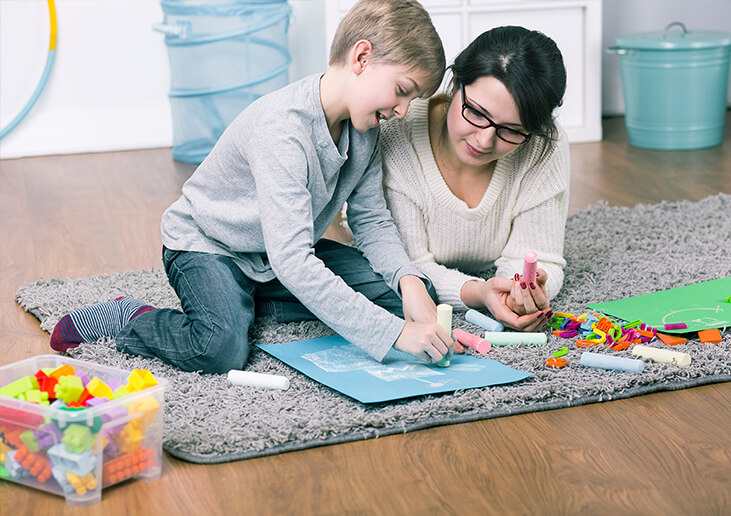Therapy Methods
Creative Therapy Activities For Children
Too often, children in schools may not be able to express their feelings. Perhaps they are overwhelmed by a medical diagnosis, school-related angst, peer pressure, social concerns or a stressful home life. If left alone, all of these factors can lead to anxiety, depression and self-harm.
Being able to help these at-risk students is especially important, however, they often don’t respond to traditional occupational therapy activities. And, while we are making progress in overcoming the stigma of seeing “the school therapist,” many therapists still have to find alternative therapy activities for children in order to engage these students. Some of these creative occupational therapy activities include drama, art and dance.
Not only do occupational therapy activities like these help reach kids in need, they also provide the play, movement, laughter and fun that child development specialists recommend for social and emotional well being. Let’s take a closer look at the benefits of these therapy activities for kids.
Drama Therapy
In New York City, one drama therapy program is helping to reach more than 2,000 students each year, based on the ENACT method created by Diana Feldman in 1987. ENACT was unique at the time because it utilized drama therapy within schools.
Current Approaches in Drama Therapy
Today, the program is customized for each school with workshops that embrace theatre arts to teach students important skills. Actors trained with the ENACT method are brought into work with a group of students for whom there are behavioral concerns. Many of these students have extreme truancy issues and are at risk of not continuing with school.
ENACT programs may be up to 30 weeks long. The actors spend time presenting scenes that are prepared specifically for their particular group. These real life conflicts are presented in a manner that is appropriate to engage the students. Roleplaying scenes are taken from real-life events in the community and recent news. While actors model them in front of the group, counselors are also around to make sure students feel safe. As scenarios unfold in front of them, students are able to identify what is similar in their own lives. With more discussion, they are able to get involved with explaining the mistakes of the actor and then take part in helping to rehearse better solutions to the problematic scene.
One of the biggest issues that ENACT works on is bullying because it happens in all schools with students of all ages, backgrounds and languages. ENACT even created a one-act play to assist schools with the growing concern of cyber bullying. Using this dramatic presentation, they are able to keep students focused on the concerns and create discussions with them.
Schools have reported that ENACT drama therapy programs have helped them decrease disciplinary concerns, increase class attendance and restore calm in classrooms.
Other Drama Therapy Programs
Schools not located in New York City should look to see what other options are available in their region. Additionally, you or someone in your district can become a Registered Drama Therapist (RDT) through the North American Drama Association so you can develop your knowledge of this valuable therapy method and begin similar drama therapy programs in your own schools.
Art Therapy
Some schools have found that implementing art therapy for children is a way to reach out to more students. The benefits of art therapy are touted among those who practice the skill often—the most obvious being that, unlike art classes, there are no skill-level divisions. Anyone can be an artist in an art therapy course.
Art has a soothing effect on many children—especially those who often get anxious or upset and won’t talk about it. Kids are able to express their feelings in a creative way and can sometimes talk through the process. Many times, repressed emotions even come to the surface. Through paintings, drawings or sketches, students can better connect with these emotions in a manner that traditional therapy does not. Art therapy allows for an individual healing process that is guided by one’s emotions, and not necessarily a set goal of completing treatment. Additionally, a short time in the art room allows these students to be able to go back to their regular classrooms to refocus on their academic tasks.
Expressive Art Therapy Activities
Art therapy for children can be done in a number of ways. Schools may consider bringing in painting and drawing supplies, gently used musical equipment for art therapy via music, or sand and water tables for younger students. The type of creative therapy used is not as important as the healing process that goes on when a student is allowed and encouraged to express their emotions through creativity.
Benefits of Art Therapy
Often, students that have experienced a loss may be unable to grieve properly. Art therapy may allow those that have been through a traumatic event to speak about it, and begin to process it with their therapist. Some students may have repressed traumatic memories and, through art therapy, were able to recall these memories and begin to treat their symptoms. Art therapy is especially beneficial for younger children that have dealt with tragedy, as they are often unable to communicate the depth of their emotions verbally. Art therapy provides them an outlet to express these feelings in a creative outlet, which may be more beneficial than a traditional therapy session or talk with a school counselor.
Art therapy can also be a way for students to help other students that have been affected by a tragedy. When a disaster strikes a school (such as a tornado or school shooting), students may feel unable to express their emotions properly. Even if friends and family attend different schools, art therapy can allow students to send gifts of art to other students, and express their feelings in a beneficial manner.
Art Therapy Room Setup
A special art room may be set up just for kids that have been identified by teachers or therapists from within the building. If the kids look like they need a safe place to go to, they may go to this art room. The art room works for children that need respite from traditional classrooms. Within the rooms, there are friendly and familiar faces that may provide children with creative ways to get what they need. Older students may have set times to go to the art therapy room. This allows them to stay in classes, but look forward to their time in the art therapy room.
To set up an art therapy room, schools need to think of a quiet space that can house different types of art supplies. School social workers and others may stay within the rooms, along with interns to provide sessions when kids are in need. It’s important to look to the community for help with supplies and funding that may be necessary due to budgetary constraints.
Dance Therapy
Children with special needs often need breaks in their school days to wiggle and move. Dance therapy can be especially beneficial for these (and all) students. Dancing is popular with many children, and allows for individual accomplishments, exercise, boosting self confidence and building motor skill development. In addition, group dance can help students work on social skills, team building and more.
What is Dance Therapy?
Dance and movement therapy began in the 1940s when it was found to help with emotional, cognitive, physical and social well-being. Today, we know that dance therapy may be beneficial for a larger population. Dance therapy brings the mind, body and spirit together to help children overcome various challenges. When children are allowed to move and dance in the middle of a stressful day, it gives them a temporary distraction. During this time, they are able to laugh, play and get much-needed energy out after sitting in class.
Dance therapy is also currently used for cancer patients. It helps these kids to better cope with their pain, frustrations and stresses that come with the realities of cancer. Many times, physical therapy sessions have included dance to work on range of motion and gross motor skills.
Benefits of Dance Movement Therapy
For kids with special needs, dance can open up a world for them. It allows them to learn to control their bodies. They may use music that soothes them to get to understand how their bodies may move. Therapists may utilize dance strategies to incorporate different areas they are working on. Occupational and physical therapists may focus on goals that they have with balance and motor skill development. Dance therapy is a nonthreatening and lower stress alternative to other physical activities.
Social workers may push into dance session to focus attention on social skills, such as how to talk when working with a partner. If they are there to encourage students, they will be able to coach them on different ways to interact that may not upset others and help them to be better understood. Speech and language pathologists may also partner up with children to work on articulation, pragmatics, and other goals that they have at the time.
Dance therapy can vary based on the group, age, and number of children who are working together. Since this is not being used as physical therapy, the key is to relax kids participating and allow them to sense calm and fun during the time. The movement often allows children to let their anger, frustrations, and stress flow out of the body and gain more confidence over time. The point in trying this in larger groups would be to help with the daily lack of movement while helping with another emotional therapy approach.
In addition, while many kids are able to be successful with traditional dance classes, it is not for everyone. Not all special needs students are able to participate in these classes outside of school. For many, the cost may be too high. For others, the demands within them are not something that they are able to keep up with. Children with special needs may feel left out because of limitations before them.
Schools that are interested in implementing this type of program should investigate local dance therapy resources, as well as how a dance therapy program could be integrated into their physical education. With the help of therapists, classroom teachers could be shown what to do on a daily basis. School therapists could then make scheduled stops into classrooms to open up communication with students and continue to check on their emotional well-being.



